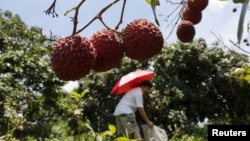A pesticide banned by international treaty in 2011 could be responsible for the deaths of young children in South Asia, according to new findings.
In June 2012, 14 children were brought to the Dinajpur Medical College Hospital in northern Bangladesh with acute encephalitis, a dangerous swelling of the brain. Most were unconscious within three hours, and all but one died after about 20 hours.
Scientists from the International Center for Diarrheal Disease Research, a major research institution in Bangladesh, investigated what caused the outbreak. The medical team noticed that almost all the children lived next to a lychee orchard, many lived with someone who worked in the industry, and most had visited the fruit orchards shortly before becoming ill, lead author Mohammed Islam told VOA.
A report published earlier this year in The Lancet reviewed a 2014 outbreak that killed 122 children in India's Muzaffarpur region, the country's largest lychee-producing region and an area where there are annual outbreaks of illness resembling acute encephalitis. That report blamed the outbreak on naturally occurring toxins in lychees that can lead to dangerously low blood-sugar levels in malnourished children.
But a new report this week by Islam and his team, who analyzed the 2012 outbreak and subsequent incidents, noted that affected areas more often are places where lychees are produced, rather than consumed. And outbreaks typically ended when monsoon rains began, washing away pesticide residues from the fruit trees.
The researchers interviewed lychee orchard workers, their families and neighbors, as well as the families of children who had not fallen ill. They learned that children frequently ate unwashed fruit that fell to the ground, and peeled away the lychees' rough-textured red skin with their teeth.
Workers in the orchards said children were sometimes recruited to help with the harvest, since they could easily climb the small lychee trees. The workers were not always able to report what pesticides were used, since the labels had been removed before pesticide containers reached the fields. However, the researchers were able to collect empty containers for testing.
The new report by Islam and his team, published in The American Journal of Tropical Medicine and Hygiene, found that a number of pesticides — including endosulfan — were being used. Endosulfan was added to the Stockholm Convention on Persistent Organic Pollutants in 2011, which should have ended its use in most of the world. However, slow implementation, numerous exceptions and weak enforcement led to continued use.
Endosulfan is permitted for use on some crops in Bangladesh, but not on lychees, Islam told VOA.
Overall, though, "There is very poor monitoring of the use of pesticides," he said.
The study was not able to definitively show that each case was caused by pesticides, or identify which pesticides were responsible for the young victims' brain inflammation. If researchers can respond rapidly to the next outbreak and collect blood samples within hours, Islam said, scientists should be able to determine which pesticides are present.
Islam said he wants to coordinate with other scientists and conduct further studies across Bangladesh and in India, Vietnam and Thailand, where similar outbreaks have been reported and endosulfan may still be used on crops.







